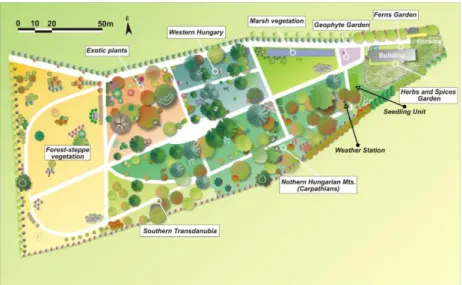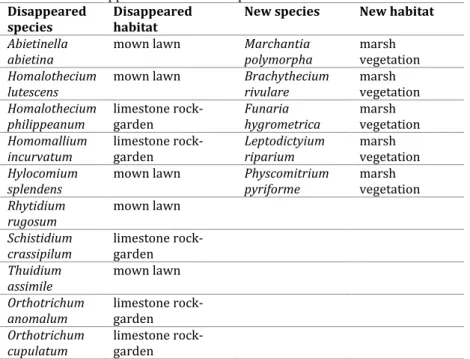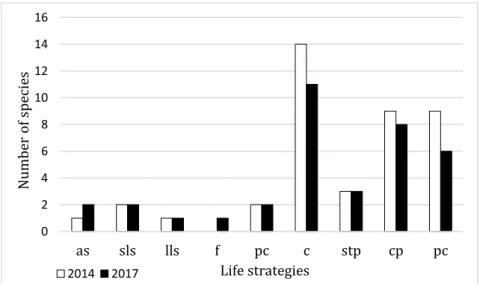SHORT-TERM CHANGES IN THE BRYOPHYTE FLORA IN THE BOTANICAL GARDEN OF ESZTERHÁZY KÁROLY UNIVERSITY
(EGER, NE HUNGARY)
Péter Szűcs*, Jana Táborská, Gergely Baranyi
& Erika Pénzes-Kónya
Eszterházy Károly University, Institute of Biology, Department of Botany and Plant Physiology, H-3300 Eger, Leányka str. 6, Hungary;
*E-mail: szucs.peter@uni-eszterhazy.hu
Abstract: Two research surveys were made to check the bryophyte species in the botanical garden: one investigation was started before the reconstruction took place and one after the works ended.
Altogether 46 taxa (2 liverworts and 44 mosses) were recorded. Changes of the bryophyte species diversity (10 mosses disappeared and 5 new mosses appeared) were evidently connected with the garden reconstruction and consequently with changes of the habitats, respectively their destruction and creation of the new ones.
Keywords: mosses, liverworts, life strategy, disturbance
INTRODUCTION
Examples of bryophyte floristical research within some European botanical gardens or arboreta could be mentioned (e. g. Vajda 1954, Ştefureac and Lungu 1961, Menzel 1984, Stech 1996, Fukarek 2006, Eckstein and Burghardt 2008, Teutsch 2011, Szűcs 2017), however botanical garden research related to short- or long-term changes of the bryophyte species diversity has not yet been accomplished. At present, the comparison of species distributions before and after certain time intervals has been carried out only in case of cities (e. g. Oxfordshire (Jones 1991), London (Duckett and Pressel 2009) or Katowice City (Stebel & Fojcik 2016)).
The objectives of our work are to examine the changes in bryophyte flora of the botanical garden of Eszterházy Károly University in reaction to the full reconstruction of the area.
MATERIAL AND METHODS
Two research efforts were made to check the bryophyte species in the botanical garden: one investigation was started before the reconstruction took place (September of 2014) and one after the works ended (June of 2017).
The evaluation of the life strategies of bryophytes comparing the most represented strategy types in two collecting times was carried out according to During (1979) and Orbán (1984).
Nomenclature follows the classification of Király (2009) for vascular plants, Papp et al. (2010) for liverworts and Hill et al.
(2006) for mosses. Specimens have been deposited in bryophyte collections of the Eszterházy Károly University in Eger (EGR).
Study area
The botanical garden (BG) of Eszterházy Károly University is situated in North-East Hungary, at the eastern border of Eger town.
The management of the garden is provided by the Department of Botany. Its territory is 1 ha and is under local protection of the Town of Eger. The BG was founded in 1967, but the complete reconstruction of the garden took place between 2011-2015: the change of its whole structure has included new habitats and sidewalks network, the introduction of a new irrigation system, and planting many new herbaceous plants and some trees. The garden has been divided according to the vegetational regions of Hungary (Figure 1) and the living collection of plants is devoted mainly to the flora of the Carpathian Basin. The collection consists of about 100 species of trees and shrubs and about 600 species of herbaceous plants. The BG is a member of Hungarian Association of Arboreta and Botanic Gardens (HAABG).
The geographical position of the BG is N47° 54' 23.9", E 20° 23' 23.6", at an altitude of 230 m a.s.l. The climate of the garden is mild with a shift to the sub-continental features, with hot summer, moderately cold winter and quite low precipitation values:
according to climate diagrams generated from 30-years global history with hourly weather data (Meteoblue 2017) and the data from Climate-data.org (2017), the average annual temperature is 9,9 °C with July and August as the warmest months and with the coldest temperatures in January. The frost-free period usually
average, there are only max. 4,3 snow days per month in winter (from October to March). The average annual precipitation reaches 543 mm with maximums in May and July. The strongest and at the same time the most frequent winds blow from West and North directions.
According to Geological map of Hungary, 1:200 000, the area of the BG belongs to Kiscelli Clay geological unit: open-marine clay, clay marly silt, clay mar. The soil type is slightly acidic brown forest soil with higher percentage of clay in the soil texture (Budai and Gyalog 2010).
Figure 1. The map of the botanical garden of Eszterházy Károly University.
RESULTS AND DISCUSSION
The changes of bryophyte species diversity are tightly connected with the garden reconstruction and consequently with changes of the habitats, respectively their destruction and creation of new ones. The most striking habitat alterations concern for example the removal of an old shadowy limestone rock-garden or the establishment of a small artifitial wetland on an area of former shrub and weedy vegetation. Through the maintenance of the wetland, occasionally plots of open surface could be found there, as
a habitat suitable for colonization by new bryophyte species (e.g.
Marchantia polymorpha, Physcomitrium pyriforme).
As an example for a regeneration process, Climacium dendroides can be mentioned from among the moss species. The distribution area of this species decreased during the works, but the moss survived and shows increasing tendency.
The central part of the garden forms a grove of high trees, most of them are over 50 years old. The dense canopy of trees has been partly opened up by thinning of weak, sick and dangerous individuals. There was no change in the species composition of epiphytes, because the old trees of the garden have not been disturbed.
The weedy herb layer under the trees has been removed and replaced by new plantations, only smaller patches at the northern edge of the garden have remained untouched.
The cause of changes in species composition of the garden was evidently the reconstruction process. Table 1 shows the disappeared and the new species after the reconstruction works.
Table 1. The disappeared and the new species after the reconstruction works.
Disappeared
species Disappeared
habitat New species New habitat Abietinella
abietina mown lawn Marchantia
polymorpha marsh vegetation Homalothecium
lutescens mown lawn Brachythecium
rivulare marsh vegetation Homalothecium
philippeanum limestone rock-
garden Funaria
hygrometrica marsh vegetation Homomallium
incurvatum limestone rock-
garden Leptodictyium
riparium marsh vegetation Hylocomium
splendens mown lawn Physcomitrium
pyriforme marsh vegetation Rhytidium
rugosum mown lawn Schistidium
crassipilum limestone rock- garden Thuidium
assimile mown lawn Orthotrichum
anomalum limestone rock- garden Orthotrichum
cupulatum limestone rock- garden
The bryophytes found in the studied area are listed below indicating species names and the substrates on which they were found. Species marked with a cross are identified as disappeared species and species with star are identified as a new species to the botanical garden. The Life strategy considered for each taxon is added.
List of taxa
In total, 46 species were found, out of these 44 were mosses and 2 liverworts.
Marchantiophyta
Frullania dilatata (L.) Dumort. (long-lived shuttle) – bark of Morus alba
*Marchantia polymorpha L. (colonist) – on wet soil Bryophyta
†Abietinella abietina (Hedw.) M.Fleisch. (perennial) – on exposed soil
Amblystegium serpens (Hedw.) Schimp. (perennial) – bark of Morus alba
Anomodon attenuatus (Hedw.) Huebener (perennial) – bark of tree
Barbula unguiculata Hedw. (colonist) – on bare soil
Brachytheciastrum velutinum (Hedw.) Ignatov & Huttunen (perennial) – on soil and bark of trees
*Brachythecium rivulare Schimp. (competitive perennial) – on wet soil
Brachythecium rutabulum (Hedw.) Schimp. (competitive perennial) – on soil
Brachythecium salebrosum (Hoffm. ex F.Weber & D.Mohr) Schimp. (competitive perennial) – bark of Morus alba
Bryum argenteum Hedw. (colonist) – on soil Bryum caespiticium Hedw. (colonist) – on soil
Calliergonella cuspidata (Hedw.) Loeske (competitive perennial) – on wet soil
Climacium dendroides (Hedw.) F.Weber & D.Mohr (competitive perennial) – on shaded and wet soil
Ceratodon purpureus (Hedw.) Brid. (colonist) – on soil Fissidens taxifolius Hedw. (colonist) – on shaded soil
*Funaria hygrometrica Hedw. (fugitive) – on disturbed and shaded soil
†Homalothecium lutescens (Hedw.) H.Rob. (perennial) – on exposed soil
†Homalothecium philippeanum (Spruce) Schimp. (perennial) – on limestone
†Homomallium incurvatum (Schrad. ex Brid.) Loeske (colonist) – on limestone
†Hylocomium splendens (Hedw.) Schimp. (competitive perennial) – on shaded and wet soil
Hypnum cupressiforme Hedw. (stress tolerant perennial) – on soil, bark of trees and stones
*Leptodictyium riparium (Hedw.) Warnst. (perennial)– on wet soil
Orthotrichum affine Schrad. ex Brid. (colonist) – bark of Acer pseudoplatanus
†Orthotrichum anomalum Hedw. (colonist)– on limestone
†Orthotrichum cupulatum Hoffm. ex Brid. (colonist) – on limestone
Orthotrichum diaphanum Schrad. ex Brid. (colonist) – bark of Morus alba, Pyrus pyraster and Acer pseudoplatanus
Orthotrichum pallens Bruch ex Brid. (pioneer colonist) – bark of Morus alba
Orthotrichum pumilum Sw. ex anon. (colonist) – bark of Morus alba and Acer pseudoplatanus
Orthotrichum speciosum Nees (short-lived shuttle) – bark of Morus alba
Orthotrichum stramineum Hornsch. ex Brid. (colonist) – bark of Acer pseudoplatanus
Orthotrichum striatum Hedw. (short-lived shuttle) – bark of Acer pseudoplatanus
Oxyrrhynchium hians (Hedw.) Loeske (pioneer colonist) – on soil
*Physcomitrium pyriforme (Hedw.) Bruch & Schimp. (annual shuttle) – on wet and bare soil
Plagiomnium cuspidatum (Hedw.) T.J.Kop. (competitive
Plagiomnium undulatum (Hedw.) T.J.Kop. (competitive perennial) – on soil
Platygyrium repens (Brid.) Schimp. (stress tolerant perennial) – bark of Morus alba
Pseudoscleropodium purum (Hedw.) M.Fleisch. (perennial) – on soil
Pylaisia polyantha (Hedw.) Schimp. (stress tolerant perennial) – bark of Morus alba
†Rhytidium rugosum (Hedw.) Kindb. (competitive perennial) – on soil
Rhytidiadelphus squarrosus (Hedw.) Warnst. (competitive perennial) – on wet soil
†Schistidium crassipilum H.H.Blom (colonist) – on limestone Sciuro-hypnum populeum (Hedw.) Ignatov & Huttunen
(perennial) – bark of Morus alba
†Thuidium assimile (Mitt.) A.Jaeger (perennial) – on soil Tortula lanceola R.H.Zander (annual shuttle) – on bare soil Tortula muralis Hedw. (colonist) – on stones and concrete Life strategies
There is a slight difference between 2014 (before reconstruction works) and 2017 (after reconstruction works) status concerning the number of species according to the life strategy categories (Figure 2).
The disappeared species belong to the colonist (Homomallium incurvatum, Orthotrichum anomalum, Orthotrichum cupulatum, Schistidium crassipilum), the competitive perennial (Hylocomium splendens, Rhytidium rugosum) and the perennial (Abietinella abietina, Homalothecium lutescens, Homalothecium philippeanum, Thuidium assimile) categories.
The new taxons belong to the annual shuttle (Physcomitrium pyriforme), fugitive (Funaria hygrometrica), colonist (Marchantia polymorpha), competivive perennial (Brachythecium rivulare) and perennial (Leptodictyium riparium) life strategy categories.
Figure 2. Life strategies of detected bryophyte species growing in the botanical garden before (2014) and after reconstruction work (2017).
(Notation: as = annual shuttle; sls = short-lived shuttle; lls = long-lived shuttle; f = fugitive; pc = pioneer colonist; c = colonist; stp = stress tolerant perennial; cp = competitive perennial and p = perennial).
Acknowledgement – The authors would like to express their gratitude to Peter Erzberger and András Vojtkó for their useful comments. The first author’s research was supported by the grant EFOP-3.6.1-16-2016-00001 (“Complex improvement of research capacities and services at Eszterházy Károly University”).
REFERENCES
BUDAI,T.&GYALOG,L. (2010). Magyarország földtani atlasza országjáróknak, 1:200 000. A Magyar Állami Földtani Intézet kiadványa, Budapest.
CLIMATE-DATA.ORG (2017). (internet source: https://en.climate-data.org/location /378/) [06.10.2017]
DURING H.J. (1979). Life strategies of Bryophytes: a preliminary review. Lindbergia 5: 2-18.
DUCKETT,J.G.&PRESSEL,S. (2009). The changing bryoflora of London. Field Bryology 98: 30–46.
ECKSTEIN,J.&BURGHARDT,M. (2008). Die Moosflora des Alten Botanischen Gartens in Göttingen. Herzogia 21: 217–227.
FUKAREK,C. (2006). Moose des Botanischen Gartens Rombergpark in Dortmund.
Decheniana 159: 87–93 0
2 4 6 8 10 12 14 16
as sls lls f pc c stp cp pc
Number of species
Life strategies 2014 2017
HILL,M.O.,BELL,N.,BRUGGEMAN-NANNAENGA,M.A.,BRUGUES,M.,CANO,M.J.,ENROTH,J., FLATBERG,K.I.,FRAHM,J.P.,GALLEGO,M.T.,GARILETTI,R.,GUERRA,J.,HEDENÄS,L., HOLYOAK,D.T.,HYVÖNEN,J.,IGNATOV,M.S.,LARA,F.,MAZIMPAKA,V.,MUNOZ,J.&
SÖDERSTRÖM,L. (2006). An annotated checklist of the mosses of Europe and Macaronesia. Journal of Bryology 28: 198–267.
JONES, E. W. (1991). The changing bryophyte flora of Oxfordshire. Journal of Bryology 16: 513–549.
KIRÁLY,G. (ed.) (2009). New Hungarian Herbal. The Vascular Plants of Hungary.
Identification key. Aggteleki Nemzeti Park Igazgatóság, Jósvafő, 616 pp.
MENZEL, M. (1984). Die Moosflora des Botanischen Gartens Berlin-Dahlem.
Verhandlungen des Berliner Botanischen Vereins 3: 25–62.
METEOBLUE (2017). Éghajlat Eger (weather web) (internet source:
https://www.meteoblue.com/hu/id%C5%91j%C3%A1r%C3%A1s/el%C5%9 1rejelz%C3%A9s/modelclimate/eger_magyarorsz%C3%A1g_721239) [11.10.2017]
ORBÁN, S. (1984). A magyarországi mohák stratégiái és T, W, R értékei. Acta Academiae Paedagogicae Agriensis Nova Series: Sectio Biologiae17:755–765.
PAPP,B.,ERZBERGER,P.,ÓDOR,P.,HOCK,ZS.,SZÖVÉNYI,P.,SZURDOKI,E.&TÓTH,Z.(2010).
Updated checklist and Red List of Hungarian Bryophytes. Studia botanica hungarica 41: 31–59.
STEBEL,A.&FOJCIK,B. (2016). Changes in the Epiphytic Bryophyte Flora in Katowice City (Poland). Cryptogamie, Bryologie 37(4): 399–414.
STECH,M. (1996). Die Moosflora des Botanischen Gartens Bonn. Herzogia 12: 207–
220.
ŞTEFUREAC,T.I. & LUNGU, L. (1961). Briofite din Grădina Botanică din Bucureşti (Bryophyten aus dem Botanischen Garten von Bukarest). Acta Botanica Horti Bucuestiensis 1960: 273–280.
SZŰCS,P. (2017). Bryophyte flora of the Botanic Garden of the University of Sopron (W Hungary). Studia botanica hungarica 48(1): 77–88.
TEUTSCH, S.E. (2011). Die Lebermoose (Marchantiophyta) und Laubmoose (Bryophyta) im Botanischen Garten Graz. Mitteilungen des naturwissenschaftlichen Vereines für Steiermark 141: 251–271.
VAJDA,L. (1954). A Vácrátóti Botanikai Kutató Intézet Természetvédelmi Parkjának mohái. (Die Moose im Naturschutzparke des Botanischen Forschungsinstitutes von Vácrátót.) Botanikai Közlemények 45: 63–66.
(submitted: 10.11.2017, accepted: 15.12.2017)


